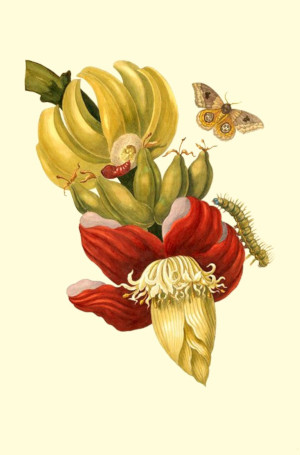LORD ROBERT JAMES PETRE (1713 - 1742)
/Patron and Plant Collector
bananas were sent to hans sloane in 1739. banana flower painting maria sybilla merian
Lord Petre, a posthumous child, was born at Ingatestone Hall on 3 June 1713. He probably derived his interest in plants and trees from his grandmother, widow of the 6th Baron; at her death in 1730, her greenhouse contained orange trees, yellow Spanish ‘jessamine’ and myrtles. At the age of fourteen, he had received a gift of a pruning knife and saw from one of the suitors of his mother, a wealthy Lancashire heiress. Philip Southcote (1697/8-1758), the youngest son of Petre’s guardian, was another kindred spirit. Petre had already met Philip Miller, keeper of the Chelsea Physic Garden, and John Martyn, who became the first professor of botany at Cambridge. By the time that Petre returned from a tour of the Continent in 1730, he had built up an extensive library, containing works on botany and gardening from Gerard to Furber. Although not yet of age, he was already gardening on his Thorndon estate. Martyn, who sponsored him for the Royal Society, in 1731 visited his stoves at Thorndon, reputed to be the largest in the world and containing pineapples, guavas, papaws, limes, passion fruit and bananas, of which he made a present to Sir Hans Sloane, another correspondent. On coming of age in 1732, Petre married and started planning the rebuilding of Thorndon Hall and landscaping the park and gardens. The project included transplanting of trees, up to 60 feet tall, some of which formed an elm avenue; he may have been inspired by Le Nôtre. Collinson wrote in 1733 that Petre ‘for so young a man…has a very surprising genius for building, designing and planting’. He was already a collector, having subscribed to the expeditions of Mark Catesby and Dr. William Houston. By 1736 Collinson had persuaded him to subscribe regularly to boxes of seeds of American forest trees collected by John Bartram. The following year he was planting these in the still surviving Octagon plantation. He planted out 4,970 trees in the park in 1740, all raised from seed in his own nurseries. During the last two years of his life, 40,000 more were added. Descriptions by Collinson and Spence of Petre’s skill in displaying variegated foliage as painting with living pencils have been often quoted. He is perhaps best known for his introduction of Camellia japonica, which flowered in 1740, but his garden flowers included New England asters, Michaelmas daisies and golden rod. Thorndon also featured a menagerie with ornamental ducks and pheasants, deer, sheep, New England red fowl, turkeys and squirrels. In his elaborate lay-out of the grounds, Petre was assisted by the Sieur Bourguinon, who was still in his employ in 1742 and has been identified as the engraver, Hubert Gravelot (1699-1773). Two well-known gardeners worked for Petre: James Huntback, from before 1732 to 1742, and James Gordon. Petre also worked as a designer on other estates, notably at Worksop for the 8th Duke of Norfolk, c.1737/8-1741; the surviving plans show details of the planting scheme and the use of ‘clumps’. Lost plans recorded in the Thorndon muniment room before the fire of 1878 include schemes for Norfolk’s estate at Buckenham, Norfolk, and, possibly, his mother’s estate at Dunkenhalgh, Lancashire, and Southcote’s Woburn, where he designed a rosary, as well as Gisburn in Yorkshire. Petre died of smallpox at Thorndon on 2 July 1742 at the age of twenty-nine. Although the plants in the nurseries were soon dispersed, with the help of Collinson and Southcote, and the Thorndon library sold in 1878, the catalogue of plants at Thorndon, commissioned from Miller in 1736, survives in the Essex Record Office, together with plans of Thorndon and Worksop. The Sutro Library in San Francisco houses 15 volumes of Petre’s hortus siccus.
Taken from: Twigs Way, Ed., Rooted in Essex (Essex Garden Trust, 2006).


